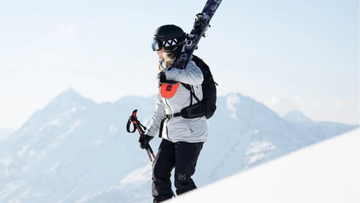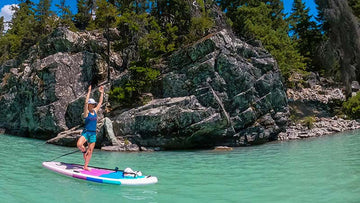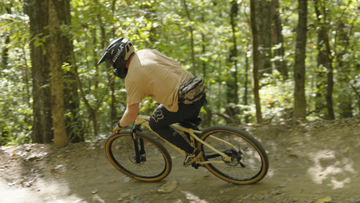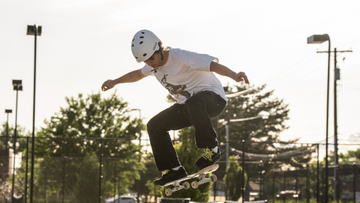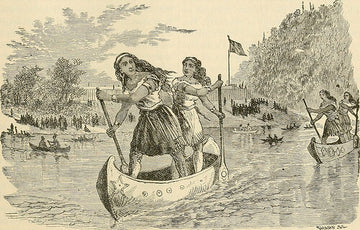
Table of content
What is the history of stand-up paddle boarding? History in Peru. History in Polynesia. History in Tel Aviv. History in the UK. History of surfing in Brazil. History of surfing in California. The popularity of stand-up paddleboard surfing.Stand-up paddle boarding is a type of sport invented out of surfing, and it is deeply rooted in modern Hawaii. The paddling boarders usually stand on the board that is moving freely on the water. The boarders use a paddle to facilitate the movement of the boardwater. It is one of the latest water sports to be invented.
The game was first recorded in a 2013 report on sports as one of the outdoor sports. Most of the people participating in the sport were from the United States in 2013. There are different types of stand-up paddleboarding. They are:

Courtesy to JLFulks
- Flatwater paddling
- Racing paddling
- Surfing
- White water stand up surfing
- Yoga paddling
- Fishing paddling
What is the history of stand-up paddle boarding?
It has been almost impossible for historians to trace back at what exact time stand-up paddling began. To grasp the actual origin of SUP, you have first to comprehend how it is done.
However, it is also tough to define what even stand-up paddling boarding is due to its diversification in modern society as a sport.
One only defining factor left of this activity is the surfing style; that you stand and paddle to propel and the use of the long staff, referred to as the paddle that the boarder uses to propel the board through the water.
It will not take you much to discover that paddling in some way began many years ago. They were considering the ancient cultures of those communities living near the water vessels.
Its history ranges from the cultures in Africa to South America. They were using canoes and many other water vessels for transport, going to war, fishing, and entertainment in the ocean waves.
All these water vessels they were using had one thing in common; they used long sticks to propel these water vessels. In ancient, the African warriors used to stand on the dugout canoes, sink their spears in the water, and paddle silently into the enemy tribe's territory to make a raid.
History in Peru

Peru fisher man
When you go back to Peruvian history, which is about 3,000 years ago, they used Caballitos de Totora, their craft, for fishing in their water bodies. They used reeds to make this craft. This improved the craft's stability that which was equated to horse riding.
Their paddle was a long bamboo shaft resembling the kayak paddle. After they were done fishing, they would have fun with the waves that would bring them back to the shore. This could be the primary origin of surfing, which led to the invention of stand-up surfing.
History in Polynesia
Stand-up surfing has a development history in different parts of the world, but modern surfing, without a doubt, began in Polynesia.
Captain James Cook was the first European to witness surfing after making sail to Hawaiian island in 1778. For them, they did not know it as surfing but referred to it as He'enalu, according to their mother language. They used canoes or their ritual crafts they made from the Koa tree, and they were curved boards.
The most extensive board belonged to the area's chief, which was around 5 meters long, while the commoners in the village used boards of 2-3 meters. He used the paddle to move in and out of the waves.
From Hawaii, we can trace the modern stand-up surfing as well.
In the 1940s, Duke Kahanamoku and Leroy and Bobby AhChoy were surf instructors in Waikiki. These instructors were standing on their boards so that they could the surfers in the ocean clearly and see the waves coming from a distance. They could use the paddles to move the boards as they stood as they were doing their duties. Later Bobby AhChoy was injured in a car accident, and as a result of those injuries, he was not able to swim or knee.
It forced him to always stand up with a cigarette lashed to his arm, a camera hanging on his neck, and paddle around while shouting instructions to his trainees. His brother Leroy and their father John would also stand spontaneously when Beach-Boy Surfing originated.

Courtesy to James Davis
In 1980, a British photographer named James Davis visited Hawaii and took a photo of AhChoy surfing. He was in a builder's hat and knees pads, and he was standing on a board in the waters, and this was stand-upping.
After this, the AhChoy'd introduced John Zapotocky to this history. Zapotocky can be considered one of the modern stand-up surfers in Hawaii. Zapotocky went to Hawaii in 1940 and fell in love with the place.
Since then, he made Hawaii his home due to the presence of the ocean. He learned SUP from Duke Kahanamoku and his fellow beach boys, and he made surfing his thing. In those days, he was just an average athlete involved in activities such as swimming, canoe racing, paddleboard, and diving.
Through his many skills in the ocean, he became such a great icon to the beach boys, who gave him the name "Pearl Diver."
To -date, John Zapotocky, goes surfing in Waikiki, and he is an excellent icon to the younger surfers all over the world. He stains to be the first oldest SUP surfer worldwide and the first first-ever surfer in the whole of Hawaii. He has been keeping his board on one of the racks on the Hawaii beach for the last 60 years. He seems to be very comfortable with the waves as he paddles out when surfing. He works with the help of the young surfers at Waikiki beach, who helps him carry his board into the ocean.
History in Tel Aviv
Hawaii was not the only root of SUP; there was also Tel Aviv, where the lifeguards at the beach were using aboard, they called Hassakeh, to do SUP.
They had gotten this skill from the fishers in hundred years back. The Hassakeh is about 5 feet wide. The lifeguards stand on it to have a good view of the water and to be able to see a victim. In case an accident happens, such as drowning, the lifeguards use double paddles to be able to move very fast and help the victim.
They then pull the victim on board. Before the boards had been designed for rescue purposes, they were small in size, and the lifeguards used them to surf in the waves while practicing rescue techniques.
History in the UK

Man in SUP paddling through the marshes of East Anglia
It is believed that this is where the first photo of SUP was first shot in East Anglia in 1886.
The picture was of a man in SUP paddling through the marshes of East Anglia, and it was named "Quantity the Marsh Hay." Also, recently in the same area, one of the events that led to the high rate of exposure and popularity of SUP was when Dave Kalama grabbed the paddle and used it in playing shooting for Oxbow on big longboards.
After Dave, Rick Thomas, Brian Keaulana, Laird Hamilton, and Archie Kalepa also began SUP as another means to do their training as the surf is down. As time went on, they participated in competitions such as Moloka'I's and the O'ahu Paddleboard Races.
After Keaulana saw that Makaha beach was becoming more popular, he decided to introduce Beach-Boy Surfing to the Buffalo Big Board Contest of 2003.
Buffalo Big Board Contest was a competition that was recognized all over the world at that time. That year, the competition attracted over 49 participants in the Standup division. This included even the elites in Hawaii watermen and the former world champion surfers. During this competition, a media house captured a photo of Laird Hamilton, and it was at this time surfing became very popular among people.
History of surfing in Brazil
It is suspected that Osmar Goncalves and Joao Roberto Hafers, two Brazilian surfers, might have been doing SUP before the Hawaiian's surfing photos were published. They were riding aboard the name Tabua Havaiana designed by Julio Putz.
They can be called the pioneers of surfing; it is only that they were not lucky to have their photos published for the new surfing that people were curious about.
History of surfing in California: invention of the modern SUP

Traditional Indian canoe race
In California was a wave ski surfer by the name of Fletcher Burton. You would not belong to credit him as a pioneer in the invention of the modern SUP.
He was using a kayak paddle to surf the wave the same way today's professional surfers do. However, he did not receive any credits from the society he lived in because they had an opposing ideology toward his surfing style. For him, he would surf while seated. Those who surfed while seated were referred to as Goat Boater, a stigmatization name, but his surfing style is the one used today by professionals.
In 2004, Rick Thomas also brought the SUP to California, and it was warmly accepted and embraced. At this point, SUP had spread almost to every corner of the world. SUP was the most significant move of this surfing industry caught up in the age of 1960s.
SUP became very commercialized in California as people made it a norm to wear surfing clothing, surfing informed a lot of talks, but only a few were allowed to surf; it was an elite thing.
The popularity of stand-up paddleboarding
In the reports by the Outdoor Found, they referred to SUP as operation of the most popular outdoor game among the first-timer players. They added that the median age of the players of the stand-up paddleboarders was twenty-eight.
According to the 2015's special reports, the Outdoor Foundation found that 2.8 million Americans, equivalent to 0.9% of the population, participated in SUP. This was an increase of 2 million people compared to the 2013 report. The highest number of participants were teenagers aged between 14-17 years. They make up 1.8% of the whole population. The sport is male-dominated, with 76% of the players as males.
Competitions of Stand-Up Paddling
However, they stated that only ISA could be able to govern, regulate, and plan for the Olympics games. By today, ISA has been able to hold several words championship as follows:
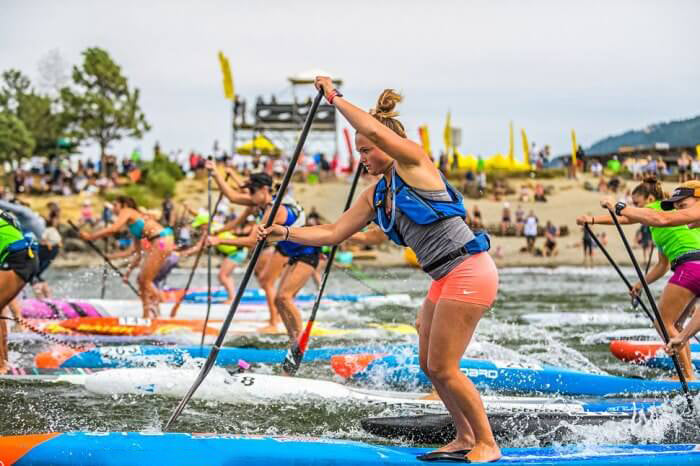
Fiona Wylde gets off the start line at her hometown race in Hood River, Oregon. Photo: Lorenzo Menendez/Flux Photography
- In 2012 and 2013 were held in Peru.
- In 2014, in Nicaragua.
- In 2015 Mexico
- In 2016 Fiji
- In 2017 Denmark
- In 2018 China
- In 2019 El Salvador
- 2020 at Great Britain
In the years to come, you shall be able to see more developments in stand-up paddleboard surfing as the game will continue to have great publicity and more fans. In the future, SUP will be the football of those days.
If you are wondering where to find your dynamic SUP buddy, don't hesitate to hop in our SUP Facebook group. You will find SUP coach, mentor, or just someone to spend time with on a Saturday afternoon. Let's promote SUP together!
[SOURCE: Wikipedia]


